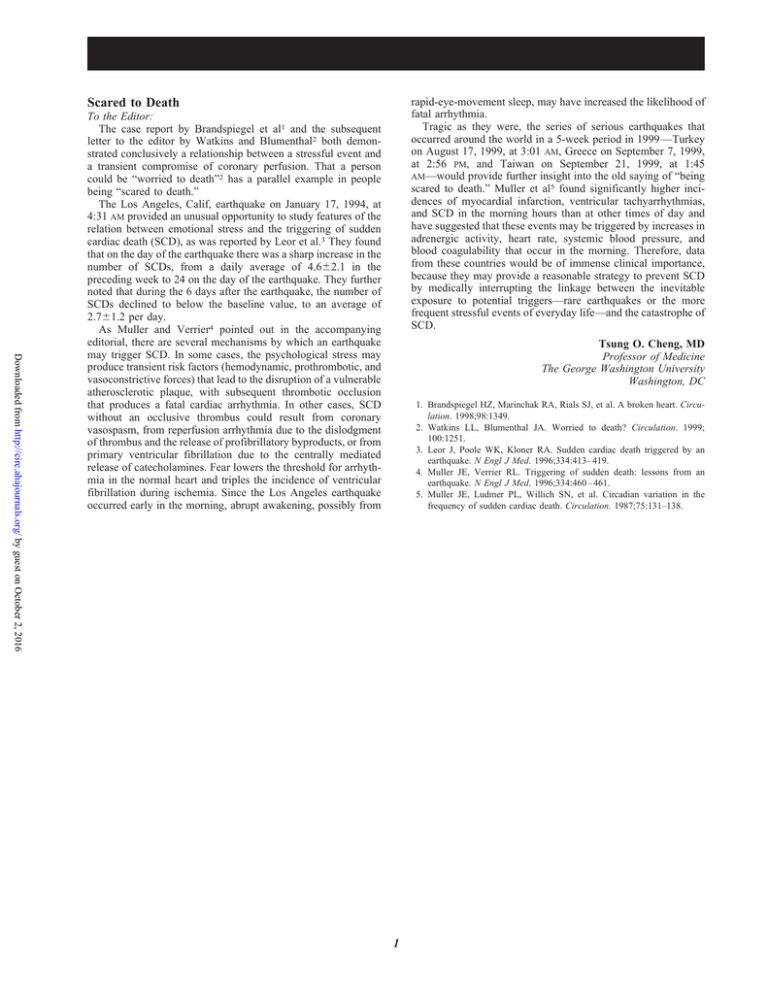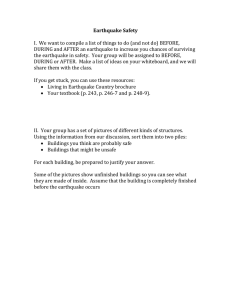
Scared to Death
rapid-eye-movement sleep, may have increased the likelihood of
fatal arrhythmia.
Tragic as they were, the series of serious earthquakes that
occurred around the world in a 5-week period in 1999 —Turkey
on August 17, 1999, at 3:01 AM, Greece on September 7, 1999,
at 2:56 PM, and Taiwan on September 21, 1999, at 1:45
AM—would provide further insight into the old saying of “being
scared to death.” Muller et al5 found significantly higher incidences of myocardial infarction, ventricular tachyarrhythmias,
and SCD in the morning hours than at other times of day and
have suggested that these events may be triggered by increases in
adrenergic activity, heart rate, systemic blood pressure, and
blood coagulability that occur in the morning. Therefore, data
from these countries would be of immense clinical importance,
because they may provide a reasonable strategy to prevent SCD
by medically interrupting the linkage between the inevitable
exposure to potential triggers—rare earthquakes or the more
frequent stressful events of everyday life—and the catastrophe of
SCD.
Downloaded from http://circ.ahajournals.org/ by guest on October 2, 2016
To the Editor:
The case report by Brandspiegel et al1 and the subsequent
letter to the editor by Watkins and Blumenthal2 both demonstrated conclusively a relationship between a stressful event and
a transient compromise of coronary perfusion. That a person
could be “worried to death”2 has a parallel example in people
being “scared to death.”
The Los Angeles, Calif, earthquake on January 17, 1994, at
4:31 AM provided an unusual opportunity to study features of the
relation between emotional stress and the triggering of sudden
cardiac death (SCD), as was reported by Leor et al.3 They found
that on the day of the earthquake there was a sharp increase in the
number of SCDs, from a daily average of 4.6⫾2.1 in the
preceding week to 24 on the day of the earthquake. They further
noted that during the 6 days after the earthquake, the number of
SCDs declined to below the baseline value, to an average of
2.7⫾1.2 per day.
As Muller and Verrier4 pointed out in the accompanying
editorial, there are several mechanisms by which an earthquake
may trigger SCD. In some cases, the psychological stress may
produce transient risk factors (hemodynamic, prothrombotic, and
vasoconstrictive forces) that lead to the disruption of a vulnerable
atherosclerotic plaque, with subsequent thrombotic occlusion
that produces a fatal cardiac arrhythmia. In other cases, SCD
without an occlusive thrombus could result from coronary
vasospasm, from reperfusion arrhythmia due to the dislodgment
of thrombus and the release of profibrillatory byproducts, or from
primary ventricular fibrillation due to the centrally mediated
release of catecholamines. Fear lowers the threshold for arrhythmia in the normal heart and triples the incidence of ventricular
fibrillation during ischemia. Since the Los Angeles earthquake
occurred early in the morning, abrupt awakening, possibly from
Tsung O. Cheng, MD
Professor of Medicine
The George Washington University
Washington, DC
1. Brandspiegel HZ, Marinchak RA, Rials SJ, et al. A broken heart. Circulation. 1998;98:1349.
2. Watkins LL, Blumenthal JA. Worried to death? Circulation. 1999;
100:1251.
3. Leor J, Poole WK, Kloner RA. Sudden cardiac death triggered by an
earthquake. N Engl J Med. 1996;334:413– 419.
4. Muller JE, Verrier RL. Triggering of sudden death: lessons from an
earthquake. N Engl J Med. 1996;334:460 – 461.
5. Muller JE, Ludmer PL, Willich SN, et al. Circadian variation in the
frequency of sudden cardiac death. Circulation. 1987;75:131–138.
1
Scared to Death
Tsung O. Cheng
Circulation. 2000;102:e98
doi: 10.1161/01.CIR.102.13.e98
Downloaded from http://circ.ahajournals.org/ by guest on October 2, 2016
Circulation is published by the American Heart Association, 7272 Greenville Avenue, Dallas, TX 75231
Copyright © 2000 American Heart Association, Inc. All rights reserved.
Print ISSN: 0009-7322. Online ISSN: 1524-4539
The online version of this article, along with updated information and services, is located on the
World Wide Web at:
http://circ.ahajournals.org/content/102/13/e98
Permissions: Requests for permissions to reproduce figures, tables, or portions of articles originally published
in Circulation can be obtained via RightsLink, a service of the Copyright Clearance Center, not the Editorial
Office. Once the online version of the published article for which permission is being requested is located,
click Request Permissions in the middle column of the Web page under Services. Further information about
this process is available in the Permissions and Rights Question and Answer document.
Reprints: Information about reprints can be found online at:
http://www.lww.com/reprints
Subscriptions: Information about subscribing to Circulation is online at:
http://circ.ahajournals.org//subscriptions/







